How to independently wind a spiral for vape
With the acquisition of experience in hover, any vaper begins to think about self-winding a spiral in an electronic cigarette. Despite the fact that you can easily buy a ready-made atomizer with an installed heating element, many bathers prefer to do this themselves, regarding this activity as a hobby. In addition to hobbies, this hobby has its advantages.
- Thanks to self-winding, you can achieve necessary resistance indicators heating element, which are significantly different from the factory.
- Rewinding the spiral, you can control the amount of steam, the temperature of the heater and regulate the force of “blow to the throat”, as well as better reveal the aroma of the liquid for soaring.
- When rewinding a heating element with your own hands a lot of money is saved, because consumables are cheaper for it than a finished atomizer.
But, before you begin to master the rewind technique, you need to have a suitable atomizer for this. Typically, bases that allow the replacement of a heating element have the abbreviation rta or rba. You can also add the rdta database to their number. The latter is a kind of drip, which has a tank for liquid.
Content
Types of materials for winding
To prepare the atomizer for operation, you must have with you such types of materials as cotton wool and wire for the helix. Vata will serve as a wick that is inside the heating element. When the latter is heated, the slurry will evaporate from it.
Materials for the heating element
For self-winding spiral vapers use the following types of materials:
- Nichrome. It is an alloy of nickel with chromium. It has a very low price and is convenient for making windings.
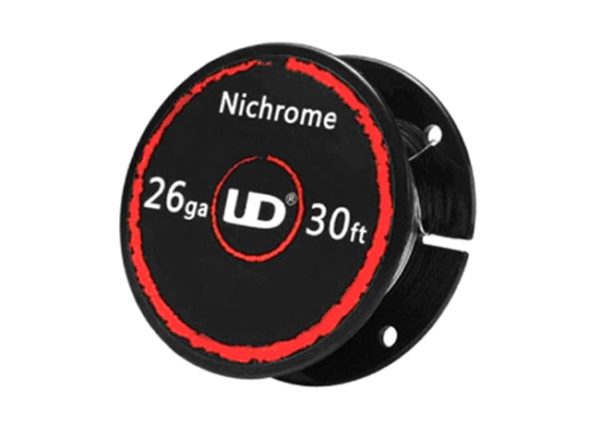
- Fechral (cantal). It is similar to nichrome, but in its structure there is no nickel. Because of this, winding from the cannel becomes even cheaper, but less durable than from nichrome.Since the fechral is slightly springy and twisted, it is less convenient if it is necessary to replace the heating element. Despite this, wire from fehral remains the most popular for vap.
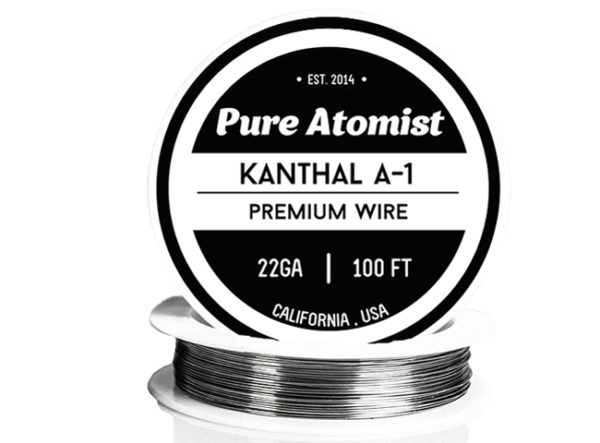
- Stainless steel. This is a material with a long life. It is also cheap and affordable, but due to its high rigidity, it is inconvenient when winding up. Therefore, homemade stainless steel winding is not common. However, with the advent of devices with the possibility of temperature control, they began to install a spiral of stainless steel, which added to its popularity. It works equally well in both the “varrivatt” mode and the “thermo control” mode. It is possible to create a heating element with high resistance - about 1 Ohm.
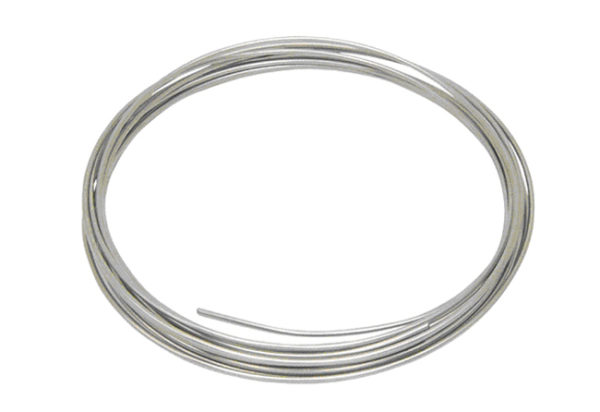
- Nickel. It is an expensive material used in devices with temperature control. Usually beginners do not use nickel for their “experiences” because of its high cost.
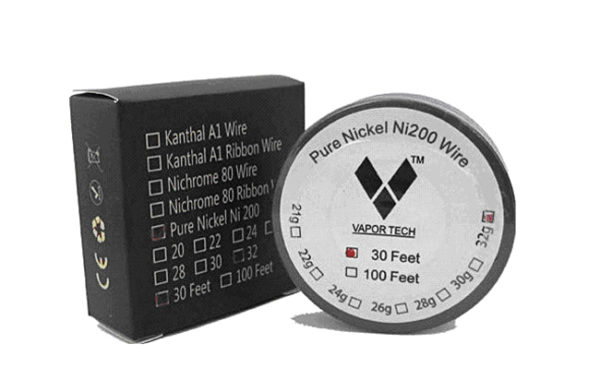
- Titanium. It is similar to nickel, but it has its advantage: when overheated, it does not emit harmful substances (such a problem is present in the heating elements made of nichrome and fehrl).
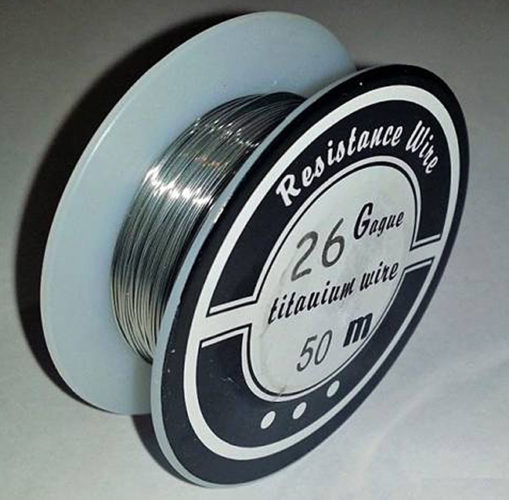
Wick Materials
To make a wick, you will need the following materials:
- Vata. Pay attention that cotton wool is non-sterile. Otherwise, “hospital taste” will appear while soaring. You can buy cotton wool in a pharmacy. Cotton pads are well suited for this purpose.
- Japanese cotton. It is considered the best material, according to vapers, from which you can make a wick that does not have third-party flavors. Cotton is very comfortable to use, but for beginners it may seem expensive.
- Silica cord. It can be called obsolete material, it is almost never used by vapers when self-winding is performed. The cord is not soaked with liquid, is not able to reveal all the aroma of the latter, is characterized by weak evaporation, although it does not burn.
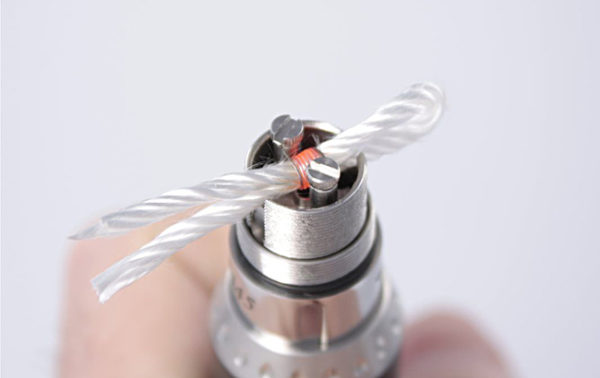
Silica cord
The importance of the resistance parameter
The resistance of the helix is the main characteristic when winding, and its value may depend on the following factors.
- Thickness. The larger the diameter of the conductor, the lower its electrical resistance. But it is worth noting that increasing the thickness will require more power consumption, which will affect the battery charge.In addition, when increasing the thickness, in order to achieve a resistance of over 0.4 ohms, it will be difficult to create turns.
- Length. The more turns in the heating element, the greater the resistance, since the “current” will need to go a longer way.
- Material. Each material for winding the heating element has its own electrical resistance parameter. Therefore, depending on the metal used, the diameter and number of rings will differ.
It should be understood that the total heating area also depends on the number of rings and their diameter. It is not difficult to guess that, the larger the area of the heating element, the more steam will be generated. But everything should be in moderation. If you wind too much spring, then it will not fit in the evaporator, and the battery will not be enough to maintain it.
Therefore, self-wrapping for vape should be carried out in accordance with Ohm's laws. If they are not taken into account, then if the mode is incorrectly wound, the mod with the electronic board will refuse to work, and the mechanic will simply burn out. For example, if you have a heating element with a resistance of 0.5 Ohm, then for its normal glow you will need a mod that can operate at 15 watts.But since it is rather difficult to find a 15-watt-holder, which can function with a low-resistance winding, you should pay attention to that the vape is suitable for power and resistance. For the most part, such devices have a power of 30 watts. Also, when choosing a battery, it is important that it be high-current. This will help avoid overheating during your experiments.
In order to achieve low resistance at low power, usually titanium or nickel wraps are used, which work correctly only in the presence of thermal control. Without this feature, they quickly fail.
Since the process of calculating all the indicators for a good wrap is quite complicated, you can use a service such as “online calculator”To calculate all the parameters of the future spiral. .
Types of spiral winding
In practice, it is customary to distinguish between the following types of windings of coils (coils).
- Microcoil It is also called nanoil. It is a spring with coils located at a minimum distance relative to each other. This method of cheating can produce a lot of steam due to the larger area of evaporation and is used in small clears.When self-winding coil must be careful to avoid inter-turn short circuit.
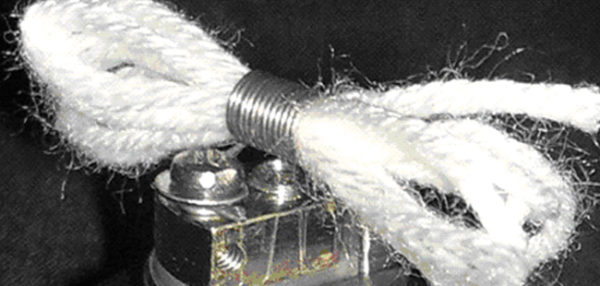
- Speicil or standard coil. This is a simple way to wind the heating element, between the turns of which a small space is saved. Due to this, the wick is better impregnated with liquid, decreases the chance of burning cotton. Although the process of making a coil itself is simple, there are also disadvantages to this method: due to the fact that the liquid does not have time to evaporate, it is possible to throw the liquid into the vaper's mouth during a sharp pull, as well as a smaller amount of steam compared to the microcoil.
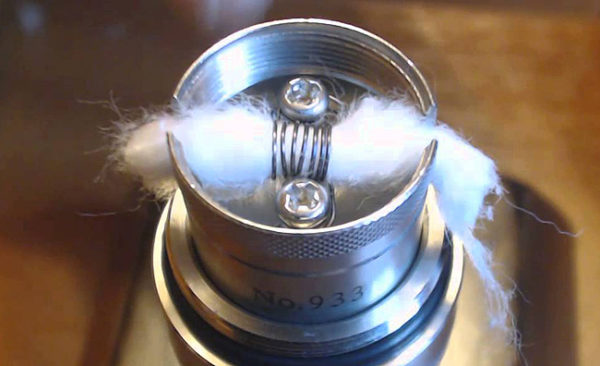
- Coyle pigtail. In this case, the coil is wound from two intertwined wires. This method of cheating increases the area of evaporation, which has a positive effect on the formation of steam and the “opening” of the taste of the vaporizing slurry. A pigtail can be wound with both a microcoil and a standard spacecraft.
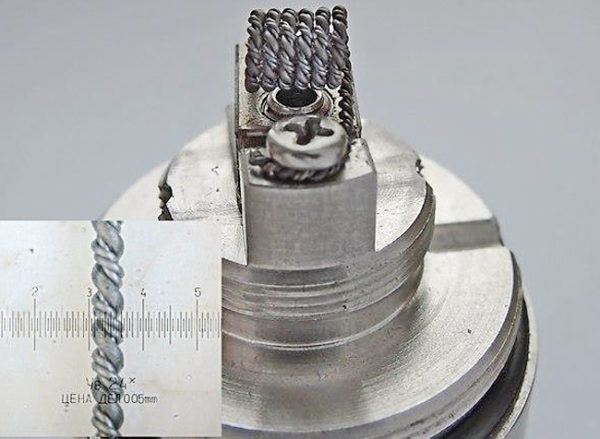
- Parallel coils. You can wind micro and speyskoyom, but from two conductors. Parallel winding increases the evaporation area and favorably influences the quantity and taste of steam, although more complex technically.
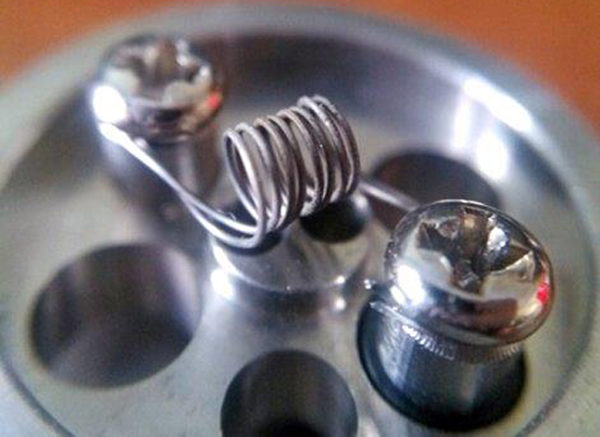
- Clapton Coil. It is similar in appearance to the bass string from a guitar, since the principle of its manufacture is similar: the outer wire is wound around the central wire.
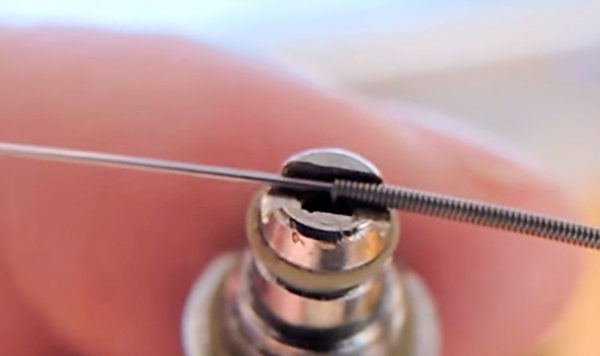
To learn how to make Clapton Coil at home, you can watch a video on this topic. - Art coils. Different from previous coils patterned weaving. To master this technique, it will take a lot of time. Due to the very large area of evaporation, the use of art coil gives a huge amount of steam with a pronounced taste. Since the winding of the art coil is a rather complicated process, it is the prerogative of the hovering professionals.
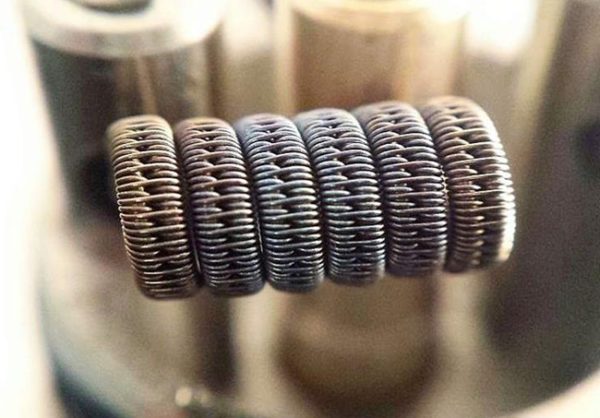
Winding technique
The instructions below will not cover how to make art coils, since this article will require an entire article to describe. So, in order to wind a spiral using the micro or space method, you will need the following tools:
- scissors;
- screwdriver;
- pliers;
- clippers;
- “Winder” - a device in the form of a probe with different diameters, which is used to facilitate the process of wrapping the coil.
- Tweezers - it is desirable that one of them be well insulated or made of ceramic, it will come in handy if you need to correct a spring under tension.
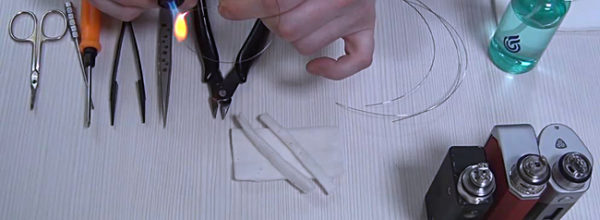
- “Winder” - a device in the form of a probe with different diameters, which is used to facilitate the process of wrapping the coil. If you do not have a “winder”, then you can use a drill for a drill of the appropriate diameter.

The process of cheating for the two options, differs slightly and is carried out as follows.
- Before starting work wash hands and tools, degrease them with alcohol. This is done to ensure that cotton wool does not absorb foreign odors, and skin fat from the fingers does not get onto it, which, when soared, will spoil the taste. This also applies to instruments, in order not to inhale the vapors with the scent of the box in which they were stored.
- Next, you need using a turbo lighter, gas burner or gas stove burner burn wireif it is noticeably springy. Glowing will make it softer and more pliable. You should not burn all the materials for cheating, but only those that are distinguished by their rigidity. Nickel and titanium wire can not be burned, because this method will significantly reduce their performance.
- Using a cotton pad and alcohol, wipe the titanium or nickel wire well.It is not necessary to wipe the wire from other materials, as they can be burned.
- Take a drill of the required diameter or “coiler” and start to wind the wire “coil to coil” on it, if it is a microcoil, and with a short distance (about 1 mm) - if it is a spike. If the turns are uneven, do not worry - then everything is easily corrected.
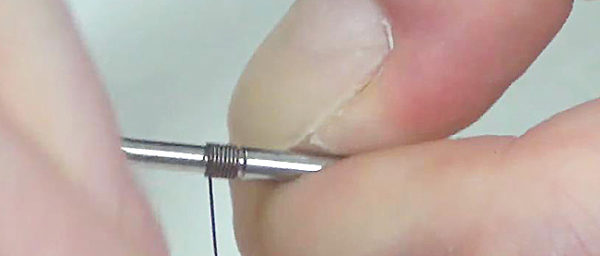
- When you wind a sufficient number of turns according to calculations on an online calculator, the microcoil can be considered ready. In the case of a Speickle, it is necessary to press it around the “winder” with pliers and stretch it a little to align it. The heating element is now ready for installation.
- Next, ready-made coil is needed. install in evaporator. If you need to change the spiral, then first remove the old one. To do this, use a screwdriver to loosen the screws on the base of the atomizer and remove the unnecessary coil, then insert the edges of the wire under them that come out of the new spring. For convenience, the "winder" can not pull.
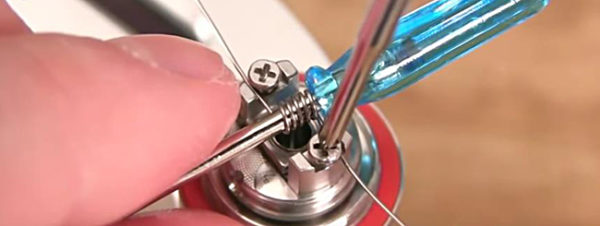
- Tighten the bolts and with the help of the same “winder” or tweezers, align the spring so that it is strictly in the center, between 2 contacts.It is necessary to take into account such a nuance: the lower it is to the central hole, the softer the soaring will be. Conversely, the higher you place it, the more tangible will be the “throat blow”. Avoid any contact of the wire with the base elements, except for the contacts provided for this.
- Take wire cutters and cut the excess wire so that they do not touch the base cover when tightening. If this is not done, there will be short circuit.
- Followed by burn coilby pressing the power key, while the power on the mode should be set in the range from 20 to 30 watts. Pressing the key should be short-lived, so that the spiral can evenly warm up (glow). Coyle should blush from center to edge. If any parts of the heating element do not heat up to red, it is necessary to hold the spring with tweezers in a manner that was previously done on the radiator with an iron key. After several such movements, the interturn short-circuit will be eliminated (there will be a minimum gap between the turns), and the coil will begin to warm up evenly.
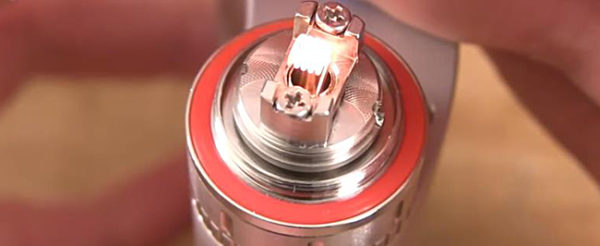
- Take a cotton or cotton pad and remove the top from it.You will need a more "fluffy" layer. Insert the wick from the wool into the spring so that it can be freely moved from side to side.
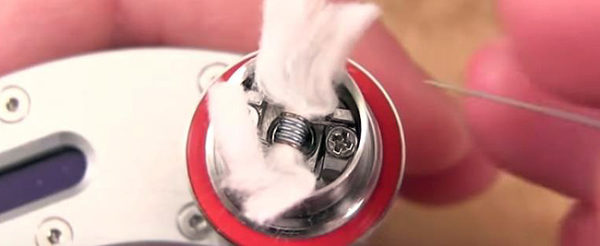
- Now you can trim off extra cotton, leaving a few millimeters around the edges (so that it does not touch the base walls). Screw the base cover and check several times so that the wick does not fall on the threads.
In this way, you can personally create a heating element for a clearomizer in an electronic cigarette, and adjust the taste and amount of steam by the number of turns of the helix and wire section. The most popular among vapers is considered cheating installed on the evaporator with a resistance of 0.3 Ohm. It is made of thin wire with a small number of turns. Which winding is better, only you can decide, since each person may have different requirements for the process of soaring, and it is simply impossible to give a universal recommendation on this matter.

/rating_off.png)











